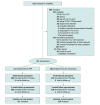Therapist-Supported Internet-Delivered Exposure and Response Prevention for Children and Adolescents With Tourette Syndrome: A Randomized Clinical Trial
- PMID: 35969401
- PMCID: PMC9379743
- DOI: 10.1001/jamanetworkopen.2022.25614
Therapist-Supported Internet-Delivered Exposure and Response Prevention for Children and Adolescents With Tourette Syndrome: A Randomized Clinical Trial
Abstract
Importance: The availability of behavior therapy for individuals with Tourette syndrome (TS) and chronic tic disorder (CTD) is limited.
Objective: To determine the efficacy and cost-effectiveness of internet-delivered exposure and response prevention (ERP) for children and adolescents with TS or CTD.
Design, setting, and participants: This single-masked, parallel group, superiority randomized clinical trial with nationwide recruitment was conducted at a research clinic in Stockholm, Sweden. Out of 615 individuals assessed for eligibility, 221 participants meeting diagnostic criteria for TS or CTD and aged 9 to 17 years were included in the study. Enrollment began in April 2019 and ended in April 2021. Data were analyzed between October 2021 and March 2022.
Interventions: Participants were randomized to 10 weeks of therapist-supported internet-delivered ERP for tics (111 participants) or to therapist-supported internet-delivered education for tics (comparator group, 110 participants).
Main outcomes and measures: The primary outcome was change in tic severity from baseline to the 3-month follow-up as measured by the Total Tic Severity Score of the Yale Global Tic Severity Scale (YGTSS-TTSS). YGTSS-TTSS assessors were masked to treatment allocation. Treatment response was operationalized as a score of 1 ("Very much improved") or 2 ("Much improved") on the Clinical Global Impression-Improvement scale.
Results: Data loss was minimal, with 216 of 221 participants (97.7%) providing primary outcome data. Among randomized participants (152 [68.8%] boys; mean [SD] age, 12.1 [2.3] years), tic severity improved significantly, with a mean reduction of 6.08 points on the YGTSS-TTSS in the ERP group (mean [SD] at baseline, 22.25 [5.60]; at 3-month follow-up, 16.17 [6.82]) and 5.29 in the comparator (mean [SD] at baseline, 23.01 [5.92]; at 3-month follow-up, 17.72 [7.11]). Intention-to-treat analyses showed that the 2 groups improved similarly over time (interaction effect, -0.53; 95% CI, -1.28 to 0.22; P = .17). Significantly more participants were classified as treatment responders in the ERP group (51 of 108 [47.2%]) than in the comparator group (31 of 108 [28.7%]) at the 3-month follow-up (odds ratio, 2.22; 95% CI, 1.27 to 3.90). ERP resulted in more treatment responders at little additional cost compared with structured education. The incremental cost per quality-adjusted life-year gained was below the Swedish willingness-to-pay threshold, at which ERP had a 66% to 76% probability of being cost-effective.
Conclusions and relevance: Both interventions were associated with clinically meaningful improvements in tic severity, but ERP led to higher response rates at little additional cost.
Trial registration: ClinicalTrials.gov identifier: NCT03916055.
Conflict of interest statement
Figures


Comment in
-
Internet-Based Cognitive Behavioral Therapy for Tourette Syndrome-Meaningfully Improving Access to Behavioral Therapy for Tics.JAMA Netw Open. 2022 Aug 1;5(8):e2225627. doi: 10.1001/jamanetworkopen.2022.25627. JAMA Netw Open. 2022. PMID: 35969404 No abstract available.
Similar articles
-
Internet-Delivered Exposure and Response Prevention for Pediatric Tourette Syndrome: 12-Month Follow-Up of a Randomized Clinical Trial.JAMA Netw Open. 2024 May 1;7(5):e248468. doi: 10.1001/jamanetworkopen.2024.8468. JAMA Netw Open. 2024. PMID: 38700867 Free PMC article. Clinical Trial.
-
Therapist-supported online remote behavioural intervention for tics in children and adolescents in England (ORBIT): a multicentre, parallel group, single-blind, randomised controlled trial.Lancet Psychiatry. 2021 Oct;8(10):871-882. doi: 10.1016/S2215-0366(21)00235-2. Epub 2021 Sep 1. Lancet Psychiatry. 2021. PMID: 34480868 Free PMC article. Clinical Trial.
-
Efficacy and cost-effectiveness of therapist-guided internet-delivered behaviour therapy for children and adolescents with Tourette syndrome: study protocol for a single-blind randomised controlled trial.Trials. 2021 Sep 30;22(1):669. doi: 10.1186/s13063-021-05592-z. Trials. 2021. PMID: 34593015 Free PMC article.
-
Tourette syndrome in a longitudinal perspective. Clinical course of tics and comorbidities, coexisting psychopathologies, phenotypes and predictors.Dan Med J. 2018 Apr;65(4):B5465. Dan Med J. 2018. PMID: 29619935 Review.
-
Behavioural Therapy for tic disorders: a comprehensive review of the literature.Expert Rev Neurother. 2024 Dec;24(12):1181-1191. doi: 10.1080/14737175.2024.2405740. Epub 2024 Sep 22. Expert Rev Neurother. 2024. PMID: 39307947 Review.
Cited by
-
Internet-Delivered Exposure and Response Prevention for Pediatric Tourette Syndrome: 12-Month Follow-Up of a Randomized Clinical Trial.JAMA Netw Open. 2024 May 1;7(5):e248468. doi: 10.1001/jamanetworkopen.2024.8468. JAMA Netw Open. 2024. PMID: 38700867 Free PMC article. Clinical Trial.
-
Tourette syndrome research highlights from 2022.F1000Res. 2023 Oct 23;12:826. doi: 10.12688/f1000research.135702.2. eCollection 2023. F1000Res. 2023. PMID: 37691732 Free PMC article. Review.
-
Telehealth Use in Medicaid: Implications for Quality Care for Individuals With ADHD and Tourette Syndrome.Public Health Rep. 2025 Aug 17:333549251357825. doi: 10.1177/00333549251357825. Online ahead of print. Public Health Rep. 2025. PMID: 40819227 Free PMC article. Review.
-
Meta-anlaysis of Internet-based Behavior Therapy for Tic Disorder.Clin Psychopharmacol Neurosci. 2025 Aug 31;23(3):453-466. doi: 10.9758/cpn.25.1294. Epub 2025 May 23. Clin Psychopharmacol Neurosci. 2025. PMID: 40660691 Free PMC article.
-
Therapist-guided, Internet-delivered cognitive behaviour therapy for adolescents with body dysmorphic disorder: A feasibility trial with long-term follow-up.Internet Interv. 2023 Nov 16;34:100688. doi: 10.1016/j.invent.2023.100688. eCollection 2023 Dec. Internet Interv. 2023. PMID: 38034863 Free PMC article.
References
-
- Woods DW, Conelea CA, Himle MB. Behavior therapy for Tourette’s disorder: utilization in a community sample and an emerging area of practice for psychologists. Prof Psychol Res Pr. 2010;41(6):518-525. doi:10.1037/a0021709 - DOI
Publication types
MeSH terms
Associated data
LinkOut - more resources
Full Text Sources
Other Literature Sources
Medical
Miscellaneous

